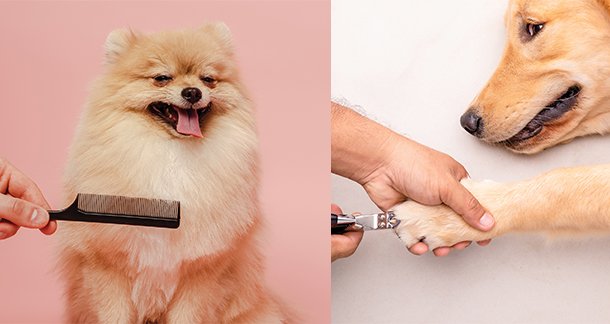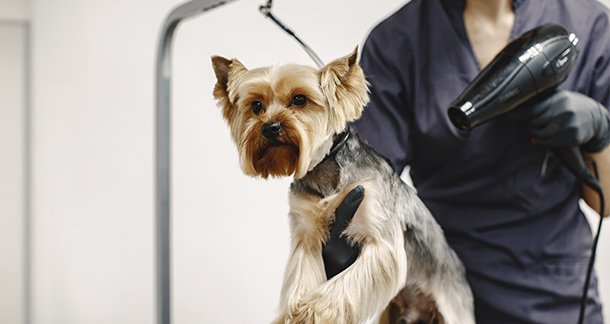Winter brings unique challenges for keeping pets comfortable, from dry skin to matted fur and exposure to harsh weather. During this time, adjusting grooming habits can protect their health and happiness throughout the season. This guide is all about why grooming matters in winters, key practices to follow, and how to make the process easier for both pets and their owners.
Why Grooming Matters in Winters
Healthy Coats
Thick or long fur can mat easily, trapping moisture and causing skin problems. Regular brushing helps prevent matting, clears dead hair, and spreads natural oils that shield pets from cold weather. The American Kennel Club notes that over half of dog owners observe skin issues in their pets during winter, often due to dryness.
Skin Care
Cold air and indoor heating can leave pets’ skin dry and irritated. Grooming removes dead skin cells while distributing oils, helping to maintain skin hydration. It also provides an opportunity to check for redness, flakes, or parasites so any issues can be addressed promptly.
Comfort and Mobility
Tangled fur can restrict movement and cause discomfort, particularly for pets with long coats. Regular grooming ensures that their fur remains smooth and manageable, providing warmth and comfort during walks and playtime.
Protection Against Hazards
Snow, ice, and salt can stick to fur and paws, leading to irritation or injuries. Grooming helps remove debris and reduce the risk of frostbite in exposed areas. Clean coats also minimise exposure to harmful chemicals found in ice-melt products.
Strengthening Bonds
Grooming is not just about hygiene; it’s a way to strengthen the bond with your pet. Positive experiences during grooming build trust and reduce anxiety, leading to a more relaxed and happy companion. Research suggests that regularly groomed pets often exhibit calmer behaviour.
Winter Grooming Practices
Brush Often
Brushing keeps fur tangle-free, distributes oils, and allows you to spot hidden issues like skin irritation or ticks. The frequency of brushing depends on the type of coat.
● Short-haired pets: Once every 1-2 weeks
● Medium-haired pets: Weekly
● Long-haired pets: 2-3 times a week or even daily
Bath with Care
Use warm water for bathing to ensure comfort, and choose hydrating shampoos with ingredients such as oatmeal or aloe vera. Thoroughly dry your pet afterwards with towels or a low-heat blow dryer to avoid chills. Limit baths to prevent stripping natural oils—once a month is usually enough.
Add Moisture
Apply moisturising sprays or conditioners with ingredients like shea butter, coconut oil, or vitamin E after baths to keep skin hydrated and fur soft. These products combat the dryness caused by indoor heating and cold air exposure.
Trim Nails
Long nails can make movement uncomfortable, especially on icy or hard surfaces. Trim your pet’s nails every 3-4 weeks. If you’re unsure about trimming, consult a professional groomer or veterinarian.

Care for Paws
Salt and ice can irritate or even injure paws. Wipe them clean with a damp cloth after walks and apply paw balm before heading out to create a protective barrier. Regularly check between toes for cuts, cracks, or ice buildup.
Focus on Ears and Eyes
Moisture from snow or rain can lead to ear infections. Clean your pet’s ears weekly and watch for redness, discharge, or unusual odours. For tear stains around the eyes, gently wipe them with a damp cloth to prevent irritation.
Dress for the Weather
For pets sensitive to cold, insulated jackets or booties can provide extra warmth. Choose snug yet non-restrictive apparel made from waterproof materials. Jackets should fit well, covering the chest and back while allowing freedom of movement.
Making Grooming Comfortable
Warm Environment
Keep the grooming area warm to ensure your pet feels relaxed. A cosy setting reduces stress and prevents chills during the session.
Stable Surfaces
Use non-slip mats or towels on grooming surfaces to prevent your pet from slipping. This ensures safety and helps them feel more secure.
Familiar Tools
Stick to brushes, clippers, and other tools your pet is accustomed to. Familiarity makes the experience less intimidating and more enjoyable for your pet.
Positive Reinforcement
Reward your pet with treats, praise, or gentle pets during and after grooming. This encourages cooperation and creates positive associations with grooming sessions.
Conclusion
So, this was all about the right practices to adopt while grooming your pet during the winter. Regular brushing, proper bathing techniques, moisturising products, nail trimming, paw care essentials, ear and eye care, and appropriate winter apparel are some of the main aspects we discussed today. All these will help you ensure your pet’s safety and warmth throughout the season. Plus, a grooming environment will be an additional advantage for both of you.
This is how you should adapt routines accordingly as a responsible owner, as your pet is an integral part of your life. I hope this guide made a positive change.

